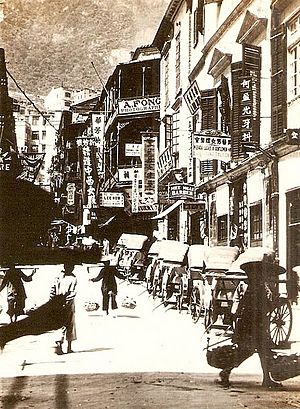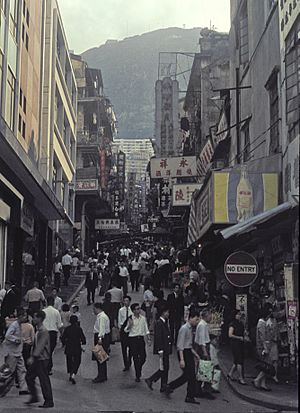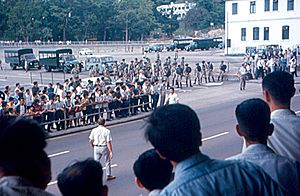British Hong Kong facts for kids
Quick facts for kids
Hong Kong
香港
|
|||||||||||||
|---|---|---|---|---|---|---|---|---|---|---|---|---|---|
| 1841–1941 1945–1997 |
|||||||||||||
|
Anthem: "God Save the King (or Queen)"
|
|||||||||||||
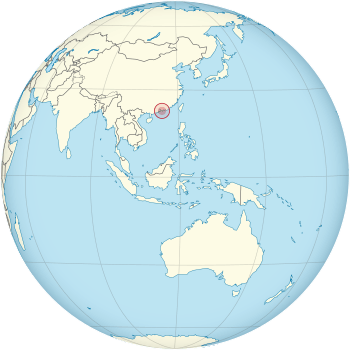 |
|||||||||||||
| Status |
|
||||||||||||
| Capital | Victoria (de facto) | ||||||||||||
| Official languages |
|
||||||||||||
| Religion | |||||||||||||
| Monarch | |||||||||||||
|
• 1841–1901
|
Victoria | ||||||||||||
|
• 1901–1910
|
Edward VII | ||||||||||||
|
• 1910–1936
|
George V | ||||||||||||
| Governor | |||||||||||||
|
• 1843–1844
|
Sir Henry Pottinger (first) | ||||||||||||
|
• 1992–1997
|
Chris Patten (last) | ||||||||||||
| Chief Secretary | |||||||||||||
|
• 1843
|
George Malcolm (first) | ||||||||||||
|
• 1993–1997
|
Anson Chan (last) | ||||||||||||
| Legislature | Legislative Council | ||||||||||||
| Historical era | Victorian era to 20th century | ||||||||||||
| 26 January 1841 | |||||||||||||
| 29 August 1842 | |||||||||||||
| 18 October 1860 | |||||||||||||
|
• Convention for the Extension of Hong Kong Territory
|
9 June 1898 | ||||||||||||
| 25 December 1941 – 30 August 1945 |
|||||||||||||
| 1 July 1997 | |||||||||||||
| Population | |||||||||||||
|
• 1996 estimate
|
6,217,556 | ||||||||||||
|
• Density
|
5,796/km2 (15,011.6/sq mi) | ||||||||||||
| GDP (PPP) | 1996 estimate | ||||||||||||
|
• Total
|
$154 billion | ||||||||||||
|
• Per capita
|
$23,843 | ||||||||||||
| GDP (nominal) | 1996 estimate | ||||||||||||
|
• Total
|
$160 billion | ||||||||||||
|
• Per capita
|
$24,698 | ||||||||||||
| Gini (1996) | ▲ 51.8 high |
||||||||||||
| HDI (1995) | very high |
||||||||||||
| Currency | Before 1895:
1895–1937:
After 1937: |
||||||||||||
|
|||||||||||||
| Today part of | |||||||||||||
| British Hong Kong | |||||||||||||
|---|---|---|---|---|---|---|---|---|---|---|---|---|---|
| Traditional Chinese | 英屬香港 | ||||||||||||
| Simplified Chinese | 英属香港 | ||||||||||||
|
|||||||||||||
British Hong Kong was a territory ruled by the United Kingdom from 1841 to 1997. It was part of the British Empire. There was a short time from 1941 to 1945 when Japan took control during World War II.
The British took over Hong Kong Island in 1841 during the First Opium War. The island was officially given to Great Britain in 1842 by the Treaty of Nanking. Hong Kong became a Crown colony in 1843. Later, in 1860, the British also gained the Kowloon Peninsula after the Second Opium War. Hong Kong grew even more in 1898 when Britain leased the New Territories for 99 years.
Even though Hong Kong Island and Kowloon were given to Britain forever, the New Territories made up most of the land. Britain didn't want to split the colony. China also didn't want to extend the lease or let Britain keep ruling. So, in 1997, the British government agreed to give all of Hong Kong back to China. This was decided in the Sino-British Joint Declaration. This agreement said that Hong Kong's way of life and economic system would stay the same for 50 years.
Contents
History of British Hong Kong
How Hong Kong Became a Colony
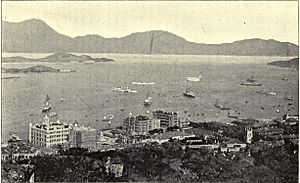
In 1836, the Chinese Qing dynasty government wanted to stop the opium trade. A special official named Lin Zexu was sent to Canton in 1839. He told foreign traders to give up their opium. He also stopped supplies to the British traders.
The British government decided that China should pay for the destroyed opium. In 1840, a British force was sent to China. The British Foreign Secretary, Lord Palmerston, said Britain did not disagree with China stopping opium. But he thought the way it was done was unfair. He wanted a safe trading base for British merchants.
In 1841, British official Charles Elliot talked with Chinese official Qishan. They made a deal called the Convention of Chuenpi. This deal gave Hong Kong Island to the British. On January 26, 1841, the British flag was raised on Hong Kong. The British commander, James Bremer, officially took control. Elliot chose Hong Kong because its harbor was good for British trade. On August 29, 1842, the Treaty of Nanking officially gave Hong Kong to Britain forever.
Hong Kong's Growth and Expansion
The first treaty did not lead to as much trade as Britain hoped. This led to pressure for new agreements. In 1856, Chinese officials in Canton arrested the crew of a ship called the Arrow. This ship was Chinese-owned but registered in Hong Kong. British officials saw this as a big insult.
In 1860, British and French forces captured Chinese forts and entered Beijing. This led to new agreements: the Treaty of Tientsin and the Convention of Peking. China agreed to open more ports and allow the opium trade. During this time, the British took over the Kowloon Peninsula. This flat land was useful for training soldiers. The area south of Boundary Street and Stonecutters Island was given to Britain in the Convention of Peking.
In 1898, Britain wanted to expand Hong Kong for defense. After talks, the Second Convention of Peking was signed on June 9. This agreement leased the rest of Kowloon, south of the Shenzhen River, and 230 islands to Britain for 99 years. These areas became known as the New Territories. Britain officially took control on April 16, 1899.
Japanese Occupation During World War II
In 1941, during World War II, Japan attacked Hong Kong. The Battle of Hong Kong began on December 8. Japanese planes quickly destroyed British air power. Two days later, Japanese troops broke through defenses in the New Territories. The British commander decided the island could not be defended for long.
On December 18, the Japanese crossed Victoria Harbour. By December 25, the British defenses were very weak. The British Governor, Sir Mark Young, agreed to surrender to avoid more losses. Many people in Hong Kong suffered during the Japanese occupation.
The Japanese took control of Hong Kong as a colony. Japanese businesses replaced British ones. However, Japan faced problems getting enough food for Hong Kong. By 1943, conditions became very difficult. When Japan surrendered in 1945, British rule returned smoothly.
British Rule Returns
On August 14, 1945, Japan announced it would surrender. British forces sailed to Hong Kong. On September 1, Rear Admiral Cecil Harcourt announced a military government. He officially accepted Japan's surrender on September 16. When Sir Mark Young returned as Governor in 1946, he wanted to give local people more say in how Hong Kong was run. This was called the "Young Plan".
Handover to China
The Sino-British Joint Declaration was signed by the leaders of the United Kingdom and China on December 19, 1984. This agreement became official on May 27, 1985. In this declaration, China said it would take back control of Hong Kong (including Hong Kong Island, Kowloon, and the New Territories) on July 1, 1997. The UK agreed to give Hong Kong back on that date.
The agreement included the "One Country, Two Systems" idea. This meant that Hong Kong would keep its capitalist system and way of life for 50 years. China's socialist system would not be used in Hong Kong. These rules were written into the Hong Kong Basic Law.
The handover ceremony happened at the Hong Kong Convention and Exhibition Centre on the night of June 30, 1997. Prince Charles of the UK gave a farewell speech for the Queen. The new British Prime Minister, Tony Blair, and the last Hong Kong governor, Chris Patten, were also there.
Representing China were President Jiang Zemin and Premier Li Peng. Tung Chee-hwa, the first Chief Executive of the Hong Kong Special Administrative Region, was also present. This important event was shown on TV and radio all over the world.
Opposition to British Rule
Some Chinese people did not like British rule. They wanted Hong Kong to be self-governing. Early protests, like the Canton–Hong Kong strike, were against British rule. Later, the 1966 riots and the 1967 Leftist riots were big protests. These were caused by worker problems and unhappiness with the government. Groups like the Anti-British Struggle Committee were formed to oppose the British government. These movements had support from both mainland China and local people.
Hong Kong's Economy Under British Rule
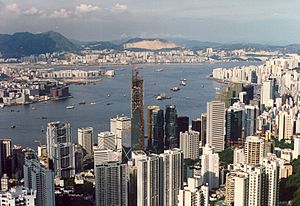
British law and government brought stability to Hong Kong. This helped Hong Kong become a major center for international trade. In the early years, money from the opium trade was important for the government. Over time, this became less important.
Even though large businesses were often run by British people, Chinese workers built the new port city. By the late 1980s, many Chinese people became very successful business leaders in Hong Kong. One example is Li Ka-shing, who became one of the richest people in the colony.
Images for kids
-
Possibly the earliest painting of Hong Kong Island, showing the waterfront settlement which became Victoria City
-
British forces reoccupy Hong Kong under Rear-Admiral Cecil Harcourt, 30 August 1945
See also
 In Spanish: Hong Kong británico para niños
In Spanish: Hong Kong británico para niños




